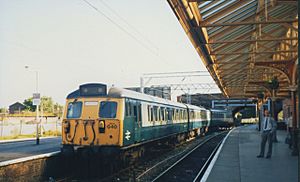British Rail Class 304 facts for kids
Quick facts for kids British Rail Class 304 |
|
|---|---|

A Class 304 EMU seen at Altrincham railway station
|
|
| In service | 1959 - 1996 |
| Manufacturer | BR Wolverton |
| Refurbishment | 1980 |
| Formation | 4 cars per trainset |
| Operator(s) | British Rail |
| Specifications | |
| Maximum speed | 75mph 121km/k |
| Weight | Total - 151tons 17cwt |
| Braking system(s) | Air (EP/Auto) |
The British Rail Class 304 was a special type of electric multiple unit (EMU) train. These trains were built in the late 1950s to help with a big project. This project was to make the main railway lines between places like Crewe, Manchester, Liverpool, and Rugby use electricity.
These trains were first called AM4 units. Later, they got the name Class 304 under a new numbering system called TOPS. You could often see them running on many parts of the southern West Coast Main Line. The Class 304 trains looked very similar to other electric trains from that time, like the Class 305 and Class 308. Sadly, none of these trains were saved for museums, and they were all eventually taken apart.
Contents
What Was the Class 304?
The Class 304 was an electric multiple unit. This means it was a train that used electricity to move. It also meant that each part of the train could power itself. These trains were made up of four connected cars. They were designed for suburban journeys, which are shorter trips around cities and towns.
Where Did These Trains Run?
These trains were very important for the first big steps of electrifying the West Coast Main Line. This is a major railway line in the United Kingdom. The Class 304 trains helped connect important cities like Crewe, Manchester, Liverpool, and Rugby. They made it easier and faster for people to travel between these places using electric power.
How Were They Designed?
The Class 304 trains were built following a specific design from 1959. This design was for trains that used alternating current (AC) electricity. They looked a lot like other trains built around the same time. For example, they looked similar to the Class 305 and Class 308 trains. They also looked like the Class 504 units, even though those used a different type of electricity called direct current (DC).
What Does AC and DC Mean?
When we talk about electricity, there are two main types: alternating current (AC) and direct current (DC). AC electricity changes direction many times a second. This is the kind of power that comes out of wall sockets in your home. DC electricity flows in only one direction. Batteries use DC power. Trains can be designed to use either AC or DC power, depending on the railway system. The Class 304 trains were built for AC lines.
What Happened to the Class 304 Trains?
The Class 304 trains served passengers for many years. They were in service from 1959 until 1996. In 1980, some of these trains were updated to keep them running well. However, after many years of use, they were eventually taken out of service. Unfortunately, no Class 304 trains were kept for people to see in museums. All of them were eventually scrapped, meaning they were taken apart and their materials were recycled.

